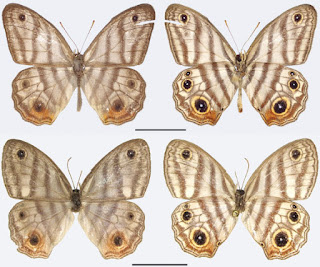തിരഞ്ഞെടുത്ത ജീവശാസ്ത്ര വാർത്തകളും കണ്ടെത്തെലുകളും 2015

തിരഞ്ഞെടുത്ത ജീവശാസ്ത്രം വാർത്തകൾ പുതിയ കണ്ടെത്തലുകൾ - 2015 ഡിസംബർ 02 ഡിസംബർ 2015-ആമസോണിൽ നിന്നും Euptychia ജെനുസിൽ പെട്ട രണ്ടു പുതിയ ഉപവിഭാഗം ചിത്ര ശലഭങ്ങളെ കണ്ടെത്തി Euptychia sophiae , Euptychia attenboroughi [4] Image credit: Andrew Neild / Trustees of the Natural History Museum, London. നവംബർ Image credit: Natural History Museum, London 03 നവംബർ 2015-മലേഷ്യയിൽ നിന്നും ഏറ്റവും ചെറിയ ഒച്ചിനെ കണ്ടെത്തി. (Acmella nana). [5] 02 നവംബർ 2015-ഈസ്റ്റ് മലേഷ്യയിൽ നിന്നും വൂല്ലി ഹോർസ്ഷൂ വാവലിന്റെ പുതിയ ഉപവർഗ്ഗത്തെ കണ്ടെത്തി . (Rhinolophus francisi). [6] ഒക്ടോബർ 18 ഒക്ടോബർ 2015-തായ്ലാന്റിൽ നിന്നും സസ്യ ശാസ്ത്രജ്ഞമാർ വാഴയുടെ പുതിയ ഉപവർഗത്തെ കണ്ടെത്തി.. (Musa nanensis). 09 ഒക്ടോബർ 2015-ഏറ്റവും ചെറിയ വണ്ടിനെ കണ്ടെത്തി ., നീളം 0.325 മില്ലി മീറ്റർ മാത്രം. (Scydosella musawasensis). 06 ഒക്ടോബർ 2015-ലോകത്തിലെ മൂന്നിൽ ഒന്ന് കള്ളിമുൾച്ചെടിക്കളും വംശനാശത്തിന്റെ വക്കിൽ ആണെന്ന് പഠന ഫലങ്ങൾ വന്നു. [7] . Image credit: Lubbert Westra / ...